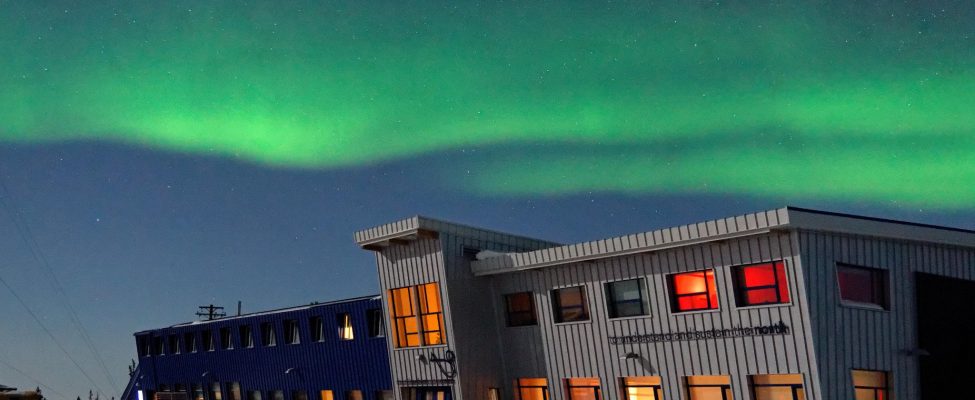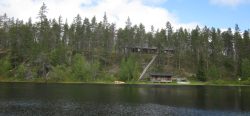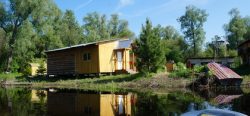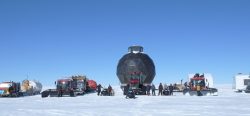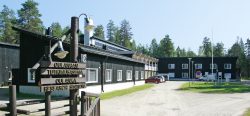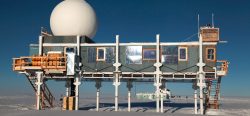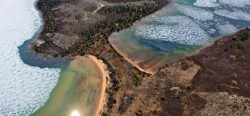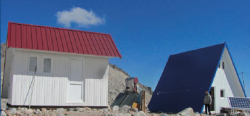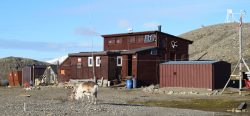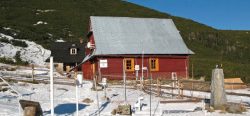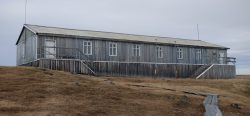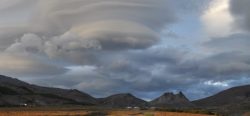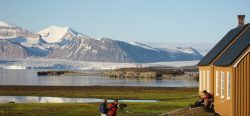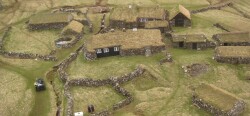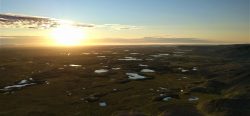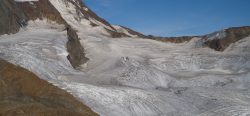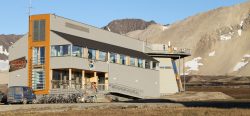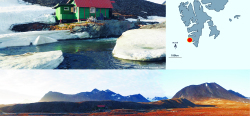STATION NAME AND OWNER
Station Name: Churchill Northern Studies Centre
Station Owner: Churchill Research Centre Inc.
LOCATION
The CNSC is an accessible northern field research station, open year-round, in Canada. It is located in a transition zone where the northern extent of the borealNorthern, from Boreas, the Greek god of the north wind.... More forest meets the southern edge of the arcticDefinitions of the Arctic vary according to environmental, geographical, political, cultural and scientific perspectives. Some scientists define the Arctic as areas having a high latitude, long winters, short, cool summers,... More tundraA type of ecosystem in which tree growth is limited by low temperatures. The origin of the word is from from the Kildin Sami word t?ndâr, meaning "uplands" or "treeless mountain tract". In the northern... More; it is also near the Churchill River, where freshwater enters the marine ecosystemAll the living organisms (including people) in an area as well as its physical environment, functioning together as a unit. An ecosystem is made up of plants, animals, microorganisms, soil,... More of Hudson Bay (58°44N, 94°49W). This convergence of ecosystems (forest, tundraA type of ecosystem in which tree growth is limited by low temperatures. The origin of the word is from from the Kildin Sami word t?ndâr, meaning "uplands" or "treeless mountain tract". In the northern... More, taigaBoreal forest, a nearly continuous belt of coniferous trees across North America and Eurasia. Taiga is dense forest with many fallen trees and marshy soil. The term derives form the southern Siberian Turkic-Mongol... More, freshwater, estuary and marine) provides an incredibly wide array of representative environments for study. As a community-based organization in the Churchill Wildlife Management Area, we serve Canadian universities, government agencies and international organizations.
BIODIVERSITY AND NATURAL ENVIRONMENT
Churchill, Manitoba, Canada is located on the west shore of Hudson Bay, 110 kilometres from the Manitoba-Nunavut. It is most famous for the many polar bears that move toward the shore from inland in the autumn, leading to the nickname “Polar Bear Capital of the World” that has helped its growing tourism industry. The landscape around Churchill is influenced by shallow soils caused by a combination of subsurface permafrostPermafrost is frozen ground that remains at or below zero degrees Celsius (32 degrees Fahrenheit) for two or more years. It forms in regions where the mean annual temperature is... More and bedrock formations. Churchill is also located at the northern edge of the Hudson Bay Lowland ecoregion. Churchill has a subarcticThe area immediately south of the Arctic circle. Generally, subarctic regions fall between 50°N and 70°N latitude, depending on local climate. In other words, the subarctic is the region between the... More climateThe average weather we would expect over a long period of time (seasons, years, decades). Climate varies from place-to-place across the Earth. Climate is determined by long-term (over at least... More with long very cold winters, and short, cool to mild summers. The prevailing wind direction is from the northwest. Churchill’s winters are colder than a location at a latitude of 58 degrees north should warrant, given its coastal location. The shallow Hudson Bay freezes, eliminating any maritime moderation.
HISTORY AND FACILITIES
Established in 1976, the mission of the CNSC is “to understand and sustain the north.” This vision is implemented through the promotion of northern research, developing and supporting educational opportunities, and serving as a vehicle for dialogue about northern issues. As such, our client base is diverse. With respect to research, the Centre facilitates the work of between 100 and 175 researchers annually. In addition, we host citizen science research programs funded by Earthwatch Institute under the “Climate ChangeAccording to the United Nations Framework Convention on Climate Change, climate change is change in the climate of the whole Earth or a region of the Earth that is believed... More at the Arctic’s Edge” program led by Drs. LeeAnn Fishback and Steve Mamet in all four seasons of the year. We deliver informal adult learning vacations focused on polar bears, birding, and northern lightsA glow in the night sky, most commonly visible at high latitudes. Sometimes appearing as shafts or curtains of coloured light. The aurora is caused when particles (mainly electrons) streaming... More. Institutionally, the CNSC has over 7,000 members, of which 2,400 are in good standing. Our membership draws from all Canadian provinces, US States, and over 50 other countries.
The CNSC operates year-round with 9 full-time year-round staff and 4-10 part-time and seasonal employees. With over 40 years of experience in arcticDefinitions of the Arctic vary according to environmental, geographical, political, cultural and scientific perspectives. Some scientists define the Arctic as areas having a high latitude, long winters, short, cool summers,... More research, including science outreach, the Centre is well positioned to continue our operations in the SubarcticThe area immediately south of the Arctic circle. Generally, subarctic regions fall between 50°N and 70°N latitude, depending on local climate. In other words, the subarctic is the region between the... More. The Centre operates primarily on a fee-for-services basis with less than 10% of its annual $1.5 million budget coming directly from government grants or subsidies.
GENERAL RESEARCH AND DATABASES
Major research conducted through the CNSC include auroral research, climate changeAccording to the United Nations Framework Convention on Climate Change, climate change is change in the climate of the whole Earth or a region of the Earth that is believed... More, climatology, greenhouse gasA gas found in the earth's atmosphere that traps heat radiated from the surface of the earth, and causes the earth's temperature to rise. The term comes from the fact... More emissions, inland water quality, marine ecosystems, northern ecologyThe study of living organisms in their environment, including where they are found and how they interact with their physical environment and with each other, for example through food webs.... More, peatlandPeat is a soil type formed from slowly decomposing vegetation. It is found in wet areas where the lack of oxygen slows the breakdown of plant matter. Peatlands are areas... More and treeline dynamics, snow pack dynamics, and wildlife management.
HUMAN DIMENSION
The nearest community is the Town of Churchill. It is located 23 km away from the CNSC. Churchill has a population of 899 people and is located on the west coast of Hudson Bay in Manitoba. The town of Churchill grew from a gathering point (circa 4000 B.P.) to a remote outpost of the Hudson Bay Company on the west side of the Churchill River to a bustling seaport with the construction of the Hudson Bay Railroad and Port of Churchill on the east side of the river in the late 1920s. Through much of the 1950s and 1960s, the town was a thriving military community servicing Fort Churchill and the Churchill Research Range. Churchill’s economy today is based on four main pillars: tourism, transportation, health and research.
The community also possesses a rich cultural history with the intersection of three aboriginal peoples (the Caribou Inuit, the Sayisi-Dene and the Maskêkô-winniwak or Swampy Cree) and, following the establishment of a Hudson Bay trading post, become home to a significant Métis population. European settlers, the Canadian and US military, and currently a temporary labour force with ties stretching to Australia and Southeast Asia round out the population of Churchill. The connection with the land and the confluence of the marine, tundraA type of ecosystem in which tree growth is limited by low temperatures. The origin of the word is from from the Kildin Sami word t?ndâr, meaning "uplands" or "treeless mountain tract". In the northern... More and borealNorthern, from Boreas, the Greek god of the north wind.... More biomes is strong in the region and has long attracted travellers.
ACCESS
Access to the station is by rail (using VIA Rail Canada from Winnipeg or Thompson, Manitoba) or by air (using Calm Air from Winnipeg or Thompson, Manitoba). Rail travel from Winnipeg is 36 hours whereas a flight is 2 hours on jet service provided by Calm Air. Freight can be shipped to Churchill using Gardewine North and arrives once per week via freight train or can be brought in by air transport. Field transportation once in Churchill can be done with vehicles using the approximately 50 km of road network in the regions. More remote use can be accomplished by ATV, snowmachine or helicopter. Camping and long-distance hiking is not recommended due to the presence of polar bears in the region.
